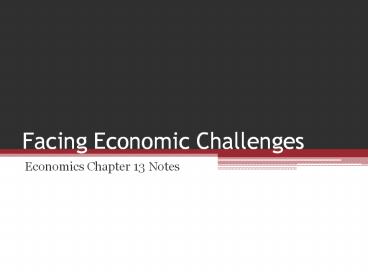Facing Economic Challenges PowerPoint PPT Presentation
1 / 22
Title: Facing Economic Challenges
1
Facing Economic Challenges
- Economics Chapter 13 Notes
2
Economic Challenges
- Three economic challenges discussed in this
chapter - Unemployment
- Poverty and Income Distribution
- Inflation
3
Economic Challenges - Unemployment
- Unemployment has a variety of causes.
- Some level of unemployment is expected, even when
an economy is healthy. - Underemployedwork part-time, want full-time or
work below skill level
4
Measuring Unemployment
- The Unemployment Rate
- Measure of unemployment
- Includes those over 16 who are not working, are
able to work and actively seeking work - Does not include military, those in prison, those
who are not seeking a job.
5
Measuring Unemployment
- Full Employment
- Always some degree of unemployment
- people relocate look for better job cant find
appropriate job - Unemployment rate of 4 to 6 percent considered
full employment in U.S. - other rates in countries with different labor
markets, economic policies
6
Types of Unemployment
- Type 1 Frictional Unemployment
- People in between jobs.
- Includes
- Childrearing parents returning to work
- new college graduates looking for first job
- experienced workers who want to switch jobs
- Reflects workers freedom to find best job for
them at highest wage
7
Types of Unemployment
- Type 2 Seasonal Unemployment
- Demand for some jobs changes dramatically from
season to season - construction work falls off in winter
- tourism peaks at certain times of year varies by
region - migrant farm work drops off in winter migrant
families suffer
8
Types of Unemployment
- Type 3 Structural Unemployment
- As businesses become more efficient, require
fewer workers - new technologies replace workers or require them
to retrain - new industries requiring specialized education do
not employ unskilled - change in consumer demand can shift type of
workers needed - offshore outsourcing sometimes leaves people out
of work
9
Types of Unemployment
- Type 4 Cyclical Unemployment
- As the nation goes through business cycles, it
faces the problems of unemployment and inflation. - Employers lay off workers during low points in
business cycle
10
Section 2Poverty and Income Distribution
- What Is Poverty?
- The Poverty Threshold
- People considered in poverty if income falls
below poverty threshold - Also called the poverty line
- Calculated based on costs of nutritious food,
other necessities
11
- The 2009 Poverty Guidelines for the 48 Contiguous
States and the District of Columbia
Number in Family Poverty Line
1 10,830
2 14,570
3 18,310
4 22,050
12
What Is Poverty?
- The Poverty Rate
- Poverty ratepercent of people in households
below poverty threshold - based on population as a whole
- Poverty does not hit all sectors of society
equally. Most at risk - Children, minorities inner-city, rural, and
singlemother families
13
Factors Affecting Poverty
- Educationthe higher the level of education, the
higher the income - Discrimination against minorities, women
- sometimes face wage discrimination, occupational
segregation - Demographic trendssingle-parent families have
more economic problems - Change from manufacturing to service jobs has
resulted in lower wages for low-skilled workers
14
Income Distribution
- Income distributionhow income is divided among
people in a nation - Income inequalityunequal distribution of
income some always exists
15
Income Distribution
16
Assistance for people in poverty
- Food stamp program gives card, government
deposits funds in account - card can be used only to buy food at grocery
stores - Medicaid offers health care funded by federal
and state governments - Earned-income tax creditrefunds taxes deducted
from paychecks - money usually spent in own communities, helping
boost their economies
17
General Antipoverty Programs
- Social Security program pays benefits to
retirees, survivors, disabled - Medicare is government health insurance for
seniors - Unemployment insurance helps laid-off workers
while looking for job
18
Section 3 Inflation
- Definition of inflation
- A sustained rise in the general price level, or a
sustained fall in the purchasing power of money.
19
What Is the Impact of Inflation?
- Effect 1 Decreasing Value of the Dollar
- Rising consumer price index represents declining
value of the dollar - People on a fixed income are especially
vulnerable - each dollar they have buys less every year
- Inflation helps people who borrow at a fixed rate
of interest
20
What Is the Impact of Inflation?
- Effect 2 Increasing Interest Rates
- Lenders raise interest rates to ensure profit on
loans - Businesses avoid borrowing to expand or make
capital improvements - Consumers less likely to finance high-priced
items - Monthly credit card payments go up as rates rise
21
What Is the Impact of Inflation?
- Effect 3 Decreasing Real Returns on Savings
- Interest on savings tends to increase during
inflationary times - Any interest you earn on investments is worth
less than it was before
22
The Effects of Inflation in the 1970s
- Background
- In the 1970s, the United States experienced the
longest period of inflation in its history. By
1979, inflation had risen to 10 percent per year
or higher. Prices of consumer goods rose
dramatically. Those on fixed incomes were
particularly affected. - Whats the Issue
- How did inflation affect people and businesses in
the 1970s? - Thinking Economically
- Name one example from each document that shows
how inflation has a negative impact on the
economy. - Inflation is a general rise in price levels. Are
the examples of price increases in documents B
and C symptoms of inflation or isolated price
increases? - Compare the tone of documents A and C. Do
economists care as much about inflation as
consumers? Explain.

